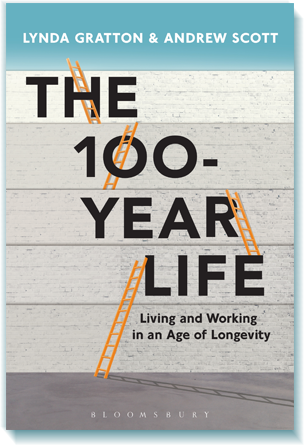
The 100-Year Life: Is It Real?
If not, even an 80- to 90-year life needs rethinking.
This post was written by Harry Margolis, a new contributor to the Squared Away Blog.

In their book, The 100-Year Life: Living and Working in an Age of Longevity (published in 2016), the psychologist Lynda Gratton and economist Andrew J. Scott predict that living a century will soon become the norm and discuss the implications of a longer lifespan on work, retirement, family life, and society.
Gratton and Scott tell us that with longer lifespans we need to abandon the concept of a three-stage life – youth and education, middle-age and working, and old-age and retirement. Instead, they say, we and our institutions need to become more flexible, allowing us to move in and out of work, time off, retraining, and changing careers.
In our sixties, we may not be financially ready to retire, especially if our savings need to finance the next 30 or 40 years. Yet, the job we trained for in our twenties may no longer exist four decades later or we may not want to do the same thing after 40 years.
Married couples may take turns working, taking time off, or going back to school, so that both partners will have opportunities to rejuvenate. Corporations, the authors say, need to become more flexible, abandoning rigid ideas of career paths in favor of creating job opportunities for those with varied experiences.
Is the 100-Year Life Realistic?
Gratton and Scott predict that the longevity gains of the last century will continue into the next and that in developed countries half of children born today will live a century or longer. This seems odd given that most life-expectancy tables say that life expectancy at birth in the United States today is just 80 years for girls and 75 years for boys. So where are the extra 20 to 25 years coming from?
The answer, they argue, is that current life expectancy projections are, in effect, backward looking, based on the living conditions and health care of people alive today. But babies born today will have very different life experiences from those born 50 or more years ago. The benefits of better health care, safer cars, and less pollution, they say, are not factored into existing life expectancy tables.
Yet, I’m skeptical. Many of the improvements in longevity have come from keeping people safe and alive into their older years and not so much extending life for those who are already old. While many more people make it into their later years than did so a century ago, those who do don’t live so much longer. Using a measure that is forward-looking and assumes general improvements over time, average life expectancy in 1950 for those age 65 in the United States was 13.1 years for men and 16.2 for women. By 2000 it had reached 17.3 and 20.0 years, respectively, just four years longer for both men and women.
By 2050, life expectancy at age 65 is projected by the Social Security actuaries to reach about 21 years for men and 23 for women, or ages 86 and 88, respectively. Of course, Gratton and Scott may argue that looking at 2050 is too soon since babies being born today won’t reach their eighties until the next century — somewhat hard to take in. But continuing the extrapolation all the way to 2100, we can expect life expectancy at age 65 to reach about 23 years for men and 26 for women, or ages 88 and 91.
Indeed, a new study published in Nature Aging finds that, in the countries with the longest-lived populations, since 1990 improvements in life expectancy have slowed down. More people are living longer as variation in life expectancy has declined, but few make it into their 100s. They conclude that “survival to age 100 years is unlikely to exceed 15% for females and 5% for males.”
Is the 100-Year Life Only Relevant to the Fortunate Few?
Further, at least in the United States, due to the “deaths of despair” described by the economists Case and Deaton and the deaths of the COVID-19 pandemic, life expectancy at birth has declined somewhat in recent years. The effects of the pandemic should soon fade from the statistics, but the fact that overall life expectancy had plateaued over the past two decades reflects the increasing inequality in the United States in finances, health, and quality of life. The affluent in the United States are doing well and their health and longevity rival that of inhabitants in other developed nations. Everyone else is falling behind.
The result is that Gratton and Scott’s book seems most aimed at those in society who will receive the benefits of longer lifespans and have the resources and ability to move in and out of jobs and retrain if necessary and desired. These are the same people who have the “luxury” of being able to take time off from work to retrain or “follow their bliss,” and to consider “encore” careers after retiring from their original one. The book may well speak to them and we can hope and work towards everyone having the same opportunities, but we’re certainly not there now.
Not Necessarily
Yet, I think a lot of what Gratton and Scott recommend makes sense even if we’re looking at 80- or 90-year lives, rather than 100-year ones. Even if the rate of longevity growth has been slowing over the past century, an 80-year life is very different from a 60- or 70-year life.
As a result, we need to think differently about how we spend our lives in terms of education, work, retirement, personal relationships, and living arrangements. In essence, Gratton and Scott urge more flexibility in all these areas as we contemplate longer lives.
For instance, the very concept of “retirement” did not exist 100 years ago. When the Social Security system was created in 1935, many people did not live until 65. (Yet, for those who did, life expectancy was already more than 10 years longer.) If we abandon the paradigm of the three-stage life, we may also drop the idea of retirement with less of a bright line between our working and post-working lives.
But we also need to make this flexibility available to everyone. This means economic security, education, and employment opportunities. If people are to be able to go in and out of work and education, as Gratton and Scott suggest, then health care coverage can no longer be tied to employment. If after retraining, older workers are going to seek new kinds of work, we need to fight age discrimination in employment. These are just two policy changes we need if we are to live more flexible lives and to rebalance the dependency ratio between the number of working and retired Americans.
For more from Harry Margolis, check out his Risking Old Age in America blog and podcast. He also answers consumer estate planning questions at AskHarry.info. To stay current on the Squared Away blog, join our free email list.






